Related Research Articles
General anaesthetics are often defined as compounds that induce a loss of consciousness in humans or loss of righting reflex in animals. Clinical definitions are also extended to include an induced coma that causes lack of awareness to painful stimuli, sufficient to facilitate surgical applications in clinical and veterinary practice. General anaesthetics do not act as analgesics and should also not be confused with sedatives. General anaesthetics are a structurally diverse group of compounds whose mechanisms encompass multiple biological targets involved in the control of neuronal pathways. The precise workings are the subject of some debate and ongoing research.

Sevoflurane, sold under the brand name Sevorane, among others, is a sweet-smelling, nonflammable, highly fluorinated methyl isopropyl ether used as an inhalational anaesthetic for induction and maintenance of general anesthesia. After desflurane, it is the volatile anesthetic with the fastest onset. While its offset may be faster than agents other than desflurane in a few circumstances, its offset is more often similar to that of the much older agent isoflurane. While sevoflurane is only half as soluble as isoflurane in blood, the tissue blood partition coefficients of isoflurane and sevoflurane are quite similar. For example, in the muscle group: isoflurane 2.62 vs. sevoflurane 2.57. In the fat group: isoflurane 52 vs. sevoflurane 50. As a result, the longer the case, the more similar will be the emergence times for sevoflurane and isoflurane.

Propofol is the active component of an intravenous anesthetic formulation used for induction and maintenance of general anesthesia. It is chemically termed 2,6-diisopropylphenol. The formulation was originally approved under the brand name Diprivan. Numerous generic offerings of this formulation now exist. Intravenous administration is used to induce unconsciousness after which anesthesia may be maintained using a combination of medications. It is manufactured as part of a sterile injectable emulsion formulation using soybean oil and lecithin, giving it a white milky coloration.

Desflurane (1,2,2,2-tetrafluoroethyl difluoromethyl ether) is a highly fluorinated methyl ethyl ether used for maintenance of general anesthesia. Like halothane, enflurane, and isoflurane, it is a racemic mixture of (R) and (S) optical isomers (enantiomers). Together with sevoflurane, it is gradually replacing isoflurane for human use, except in economically undeveloped areas, where its high cost precludes its use. It has the most rapid onset and offset of the volatile anesthetic drugs used for general anesthesia due to its low solubility in blood.
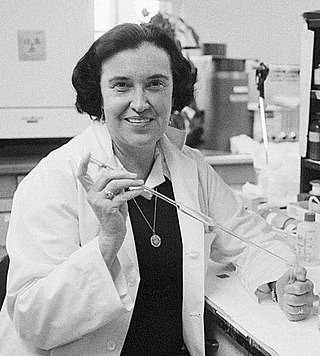
Rosalyn Sussman Yalow was an American medical physicist, and a co-winner of the 1977 Nobel Prize in Physiology or Medicine for development of the radioimmunoassay technique. She was the second woman, and the first American-born woman, to be awarded the Nobel Prize in Physiology or Medicine.
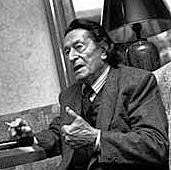
Henri Laborit was a French surgeon, neurobiologist, writer and philosopher. In 1952, Laborit was instrumental in the development of the drug chlorpromazine, published his findings, and convinced three psychiatrists to test it on a patient, resulting in great success. Laborit was recognized for his work, but as a surgeon searching for an anesthetic, he came to be at odds with psychiatrists who made their own discoveries and competing claims.

Joan Elaine Argetsinger Steitz is Sterling Professor of Molecular Biophysics and Biochemistry at Yale University and Investigator at the Howard Hughes Medical Institute. She is known for her discoveries involving RNA, including ground-breaking insights into how ribosomes interact with messenger RNA by complementary base pairing and that introns are spliced by small nuclear ribonucleic proteins (snRNPs), which occur in eukaryotes. In September 2018, Steitz won the Lasker-Koshland Award for Special Achievement in Medical Science. The Lasker award is often referred to as the 'American Nobel' because 87 of the former recipients have gone on to win Nobel prizes.
Veterinary anesthesia is anesthesia performed on non-human animals by a veterinarian or a Registered Veterinary Technician. Anesthesia is used for a wider range of circumstances in animals than in people, due to animals' inability to cooperate with certain diagnostic or therapeutic procedures. Veterinary anesthesia includes anesthesia of the major species: dogs, cats, horses, cattle, sheep, goats, and pigs, as well as all other animals requiring veterinary care such as birds, pocket pets, and wildlife.
Emery Neal Brown is an American statistician, neuroscientist, and anesthesiologist. He is the Warren M. Zapol Professor of Anesthesia at Harvard Medical School and at Massachusetts General Hospital (MGH), and a practicing anesthesiologist at MGH. At MIT he is the Edward Hood Taplin Professor of Medical Engineering and professor of computational neuroscience, the associate director of the Institute for Medical Engineering and Science, and the Director of the Harvard–MIT Program in Health Sciences and Technology.
Paul Frederick White, FANZCA is a researcher in anesthesiology, research consultant at Cedars-Sinai Medical Center at Los Angeles, retired professor and former holder of the Margaret Milam McDermott Distinguished Chair of Anesthesiology at The University of Texas Southwestern Medical Center at Dallas, and the author and editor of several journals and textbooks on the subject. With over 450 peer-reviewed publications and authorship in 9 anesthesiology textbooks, White has helped shape and revolutionize the field of ambulatory anesthesia and intravenous anesthesia.
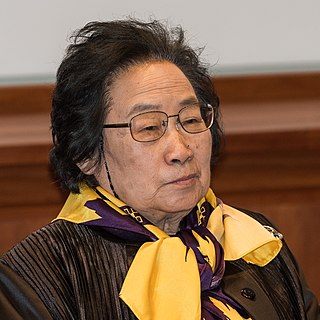
Tu Youyou is a Chinese malariologist and pharmaceutical chemist. She discovered artemisinin and dihydroartemisinin, used to treat malaria, a breakthrough in twentieth-century tropical medicine, saving millions of lives in South China, Southeast Asia, Africa, and South America.

James Patrick Allison is an American immunologist and Nobel laureate who holds the position of professor and chair of immunology and executive director of immunotherapy platform at the MD Anderson Cancer Center at the University of Texas.

Sir Peter John Ratcliffe, FRS, FMedSci is a British physician-scientist who is trained as a nephrologist. He was a practising clinician at the John Radcliffe Hospital, Oxford and Nuffield Professor of Clinical Medicine and head of the Nuffield Department of Clinical Medicine at the University of Oxford from 2004 to 2016. He has been a Fellow of Magdalen College, Oxford since 2004. In 2016 he became Clinical Research Director at the Francis Crick Institute, retaining a position at Oxford as a member of the Ludwig Institute of Cancer Research and director of the Target Discovery Institute, University of Oxford.
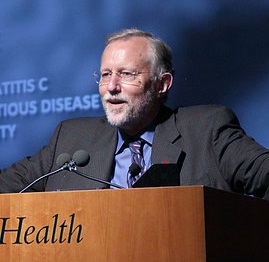
Charles Moen Rice is an American virologist and Nobel Prize laureate whose main area of research is the hepatitis C virus. He is a professor of virology at the Rockefeller University in New York City and an adjunct professor at Cornell University and Washington University School of Medicine. At the time of the award he was a faculty at Rockefeller.

Gregg Leonard Semenza is a pediatrician and Professor of Genetic Medicine at the Johns Hopkins School of Medicine. He serves as the director of the vascular program at the Institute for Cell Engineering. He is a 2016 recipient of the Albert Lasker Award for Basic Medical Research. He is known for his discovery of HIF-1, which allows cancer cells to adapt to oxygen-poor environments. He shared the 2019 Nobel Prize in Physiology or Medicine for "discoveries of how cells sense and adapt to oxygen availability" with William Kaelin Jr. and Peter J. Ratcliffe. Semenza has had ten research papers retracted due to falsified data.
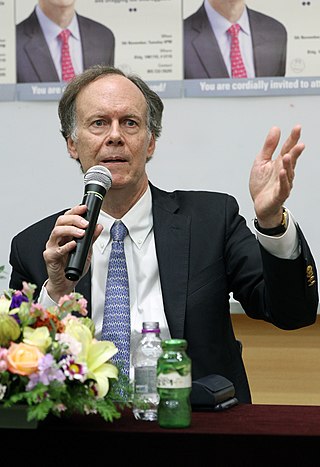
William G. Kaelin Jr. is an American Nobel laureate physician-scientist. He is a professor of medicine at Harvard University and the Dana–Farber Cancer Institute. His laboratory studies tumor suppressor proteins. In 2016, Kaelin received the Albert Lasker Award for Basic Medical Research and the AACR Princess Takamatsu Award. He also won the Nobel Prize in Physiology or Medicine in 2019 along with Peter J. Ratcliffe and Gregg L. Semenza.
Target-controlled infusion (TCI) automates the dosing of intravenous drugs during surgery. After the anesthetist sets the desired parameters in a computer and presses the start button, the system controls the infusion pump, while being monitored by the anesthetist. TCI is as safe and effective as manually controlled infusion.
Patrick Lee Purdon is an American biomedical engineer whose research focuses on neuroscience, neuroengineering, and clinical applications. He holds the Nathaniel M. Sims Endowed Chair in Anesthesia Innovation and Bioengineering at Massachusetts General Hospital and is an associate professor of anaesthesia at Harvard Medical School. Purdon received his Ph.D. in biomedical engineering from Massachusetts Institute of Technology in 2005. His research in neuroengineering encompasses the mechanisms of anesthesia, Alzheimer’s disease and brain health, anesthesia and the developing brain, neural signal processing, and the development of novel technologies for brain monitoring. He has published over 90 peer-reviewed publications, is an inventor on 16 pending patents, and is a Fellow of the American Institute for Medical and Biological Engineering. Purdon has won many awards, including the prestigious National Institutes of Health Director’s New Innovator Award, and his work has been covered in the popular media, including programs on Radiolab and NPR.
Total intravenous anesthesia (TIVA) refers to the intravenous administration of anesthetic agents to induce a temporary loss of sensation or awareness. The first study of TIVA was done in 1872 using chloral hydrate, and the common anesthetic agent propofol was licensed in 1986. TIVA is currently employed in various procedures as an alternative technique of general anesthesia in order to improve post-operative recovery.

Talmage D. Egan is an anesthesiologist, academic, entrepreneur, and author. He is a professor and chair in the department of anesthesiology, and an adjunct professor in the departments of pharmaceutics, bioengineering, and neurosurgery at the University of Utah School of Medicine.
References
- ↑ Thomas, Katie (11 September 2018). "Lasker Awards Given for Work in Genetics, Anesthesia and Promoting Women in Science" – via NYTimes.com.
- ↑ Hofschneider, Mark. "Discovery and development of propofol, a widely used anesthetic". Lasker Foundation.
- ↑ https://laskerfoundation.org/winners/discovery-and-development-of-propofol-a-widely-used-anesthetic/
- 1 2 "If you've had anesthesia, you can likely thank this veterinarian who just won a top science prize". www.science.org.
- ↑ Dankoski, Elyse (1 October 2018). "The 2018 Lasker~DeBakey Clinical Medical Research Award recognizes John Baird Glen for the discovery of propofol". The Journal of Clinical Investigation. 128 (10): 4198–4200. doi:10.1172/JCI124375. PMC 6159986 – via www.jci.org.
- ↑ https://pubs.asahq.org/anesthesiology/article/129/6/1055/18248/John-Iain-Glen-Wins-2018-Lasker-Prize-for
- ↑ "British vet wins top research award for breakthrough anaesthetic". the Guardian. 11 September 2018.